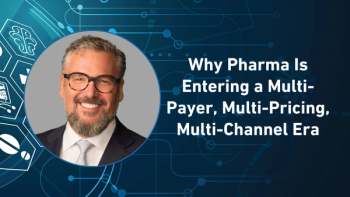
- Pharmaceutical Commerce - May/June 2015
New EMD Serono Specialty Digest finds 'site of care' management a top payer priority
Do you know your J codes?
Administering infusions at the lowest-cost center is the top goal for payers in 2014. Credit: EMD Serono
The 11th edition of the EMD Serono Specialty Digest, released in early April at the Academy of Managed Care Pharmacy meeting (San Diego, CA), highlights—for the first time in the survey—a new priority for payers: preferentially managing the site of care (hospital, clinic, doctor’s office, home) for specialty products. The question hadn’t been asked in the previous survey, but now 71% of the payers surveyed (a group representing over 100 million covered lives) say that is their 2015 priority. That result, combined with other cost- and utilization-management practices surveyed by EMD Serono, sets the stage for dramatic shifts in how specialty drugs (a fast-growing part of the pharma industry, and the focus of most new drug introductions) are distributed, rebated and dispensed. And that, in turn, will drive commercial operations and marketing practices of most manufacturers.
The survey (accessible at
- 91% of payers require prior authorization for specialty products
- 71% have a top goal of moving specialty infusion to lowest-cost site of service; and while 8% of the payers currently see savings >20% in drug costs through this action today, 20% of payers expect to see savings of that level going forward
- While 64% of payers listed “improve patient adherence” as a top goal in 2013, that has dropped to 39% in 2014 (on the other hand, payers also report significant satisfaction with the adherence services offered by SPPs)
- “Outcomes-based contracting,” where reimbursements (including for drug cost) are based on achieving health improvement goals, is something of a non-starter; 10% of plans have one or more such contracts for specialty products, and 64% say they have “no plan to implement in next 12-24 months”
- 21% of payers currently use “clinical pathways” to manage oncology therapy; an additional 24% plan to implement pathways in the next 12 months. Of those currently using them, 69% contract with a third-party vendor.
The overall impression from the Digest is of a struggle by payers to get a grip on rapidly changing practices in healthcare where specialty products are involved. The range of discounting (something that pharmacy benefit managers play a role in) varies from ASP+6% (average sales price) to ASP+20%; on average wholesale price, it’s AWP-0% to AWP-26%. EMD Serono notes that tracking drug costs under medical benefit claims is challenging for payers. “Unlike pharmacy benefit claims, which are processed online and in real-time with a drug-specific NDC code, medical claims are typically submitted post-service and drugs are coded with a less specific HCPCS J-code.” But only 71% of payers get the NDC data, and only 66% of them reconcile the NDC code with the prior-authorization information. Future cost-management strategies include policies around tumor genome sequencing and molecular diagnostics, specialty drug cost-share tiers, and site-of-service management.
The survey (viewable
- 91% of payers require prior authorization for specialty products
- 71% have a top goal of moving specialty infusion to lowest-cost site of service; and while 8% of the payers currently see savings >20% in drug costs through this action today, 20% of payers expect to see savings of that level going forward
- While 64% of payers listed “improve patient adherence” as a top goal in 2013, that has dropped to 39% in 2014 (on the other hand, payers also report significant satisfaction with the adherence services offered by SPPs)
- “Outcomes-based contracting” where reimbursements (including for drug cost) are based on achieving health improvement goals, is something of a non-starter; 10% of plans have one or more such contracts for specialty products; and 64% say they have “no plan to implement in next 12-24 months”
- 21% of payers currently use “clinical pathways” to manage oncology therapy; an additional 24% plan to implement pathways in the next 12 months. Of those currently using them, 69% contract with a third-party vendor.
The overall impression from the Digest is of a struggle by payers to get a grip on rapidly changing practices in healthcare where specialty products are involved. The range of discounting (something that pharmacy benefit managers play a role in) varies from ASP+6% (average sales price) to ASP+20%; on average wholesale price, it’s AWP-0% to AWP-26%. EMD Serono notes that tracking drug costs under medical benefit claims is challenging for payers—“Unlike pharmacy benefit claims, which are processed online and in real-time with a drug-specific NDC code, medical claims are typically submitted post-service and drugs are coded with a less specific HCPCS J-code.” But only 71% of payers get the NDC data, and only 66% of them reconcile the NDC code with the prior-authorization information. Future cost-management strategies include policies around tumor genome sequencing and molecular diagnostics, specialty drug cost-share tiers; and site-of-service management.
Articles in this issue
over 10 years ago
Understanding the companion-diagnostics environmentover 10 years ago
HPCLC Spring Meeting recapover 10 years ago
Pharmaceutical Commerce at 10over 10 years ago
A Conversation with Shabbir Dahod, TraceLinkover 10 years ago
A Big Data approach to patient engagement and adherenceover 10 years ago
What makes specialty pharmacies 'special'?over 10 years ago
2015 Product Security Reportover 10 years ago
Compliance packaging vendors keep innovatingover 10 years ago
US spending on drugs hit $373.9 billion in 2014, up 13.1%Newsletter
Stay ahead in the life sciences industry with Pharmaceutical Commerce, the latest news, trends, and strategies in drug distribution, commercialization, and market access.



